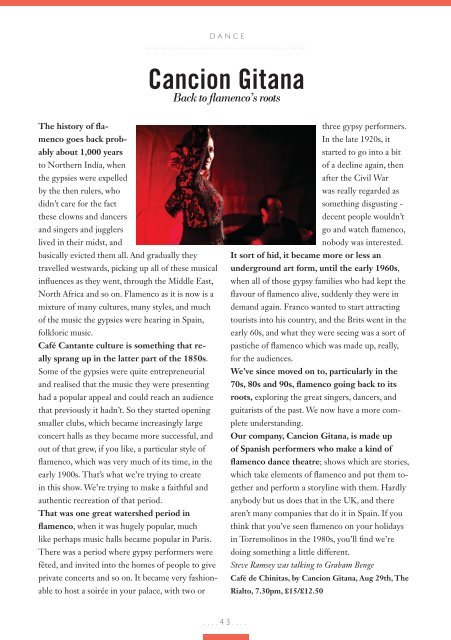Create successful ePaper yourself
Turn your PDF publications into a flip-book with our unique Google optimized e-Paper software.
dance.........................................Cancion GitanaBack to flamenco’s rootsThe history of flamencogoes back probablyabout 1,000 yearsto Northern India, whenthe gypsies were expelledby the then rulers, whodidn’t care for the factthese clowns and dancersand singers and jugglerslived in their midst, andbasically evicted them all. And gradually theytravelled westwards, picking up all of these musicalinfluences as they went, through the Middle East,North Africa and so on. Flamenco as it is now is amixture of many cultures, many styles, and muchof the music the gypsies were hearing in Spain,folkloric music.Café Cantante culture is something that reallysprang up in the latter part of the 1850s.Some of the gypsies were quite entrepreneurialand realised that the music they were presentinghad a popular appeal and could reach an audiencethat previously it hadn’t. So they started openingsmaller clubs, which became increasingly largeconcert halls as they became more successful, andout of that grew, if you like, a particular style offlamenco, which was very much of its time, in theearly 1900s. That’s what we’re trying to createin this show. We’re trying to make a faithful andauthentic recreation of that period.That was one great watershed period inflamenco, when it was hugely popular, muchlike perhaps music halls became popular in Paris.There was a period where gypsy performers werefêted, and invited into the homes of people to giveprivate concerts and so on. It became very fashionableto host a soirée in your palace, with two orthree gypsy performers.In the late 1920s, itstarted to go into a bitof a decline again, thenafter the Civil Warwas really regarded assomething disgusting -decent people wouldn’tgo and watch flamenco,nobody was interested.It sort of hid, it became more or less anunderground art form, until the early 1960s,when all of those gypsy families who had kept theflavour of flamenco alive, suddenly they were indemand again. Franco wanted to start attractingtourists into his country, and the Brits went in theearly 60s, and what they were seeing was a sort ofpastiche of flamenco which was made up, really,for the audiences.We’ve since moved on to, particularly in the70s, 80s and 90s, flamenco going back to itsroots, exploring the great singers, dancers, andguitarists of the past. We now have a more completeunderstanding.Our company, Cancion Gitana, is made upof Spanish performers who make a kind offlamenco dance theatre; shows which are stories,which take elements of flamenco and put them togetherand perform a storyline with them. Hardlyanybody but us does that in the UK, and therearen’t many companies that do it in Spain. If youthink that you’ve seen flamenco on your holidaysin Torremolinos in the 1980s, you’ll find we’redoing something a little different.Steve Ramsey was talking to Graham BengeCafé de Chinitas, by Cancion Gitana, Aug 29th, TheRialto, 7.30pm, £15/£12.50....43....


















